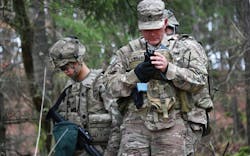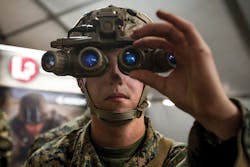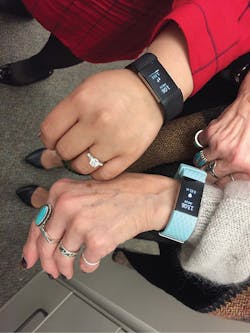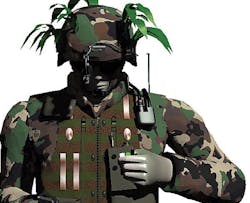Military wearable computing hits the mainstream
Warfighters capitalize on Internet of Things (IoT) technology, secure networking, and batteries to create tactical smartphone-like computing for the infantry, as well as new generations of smart clothing with electronics built-in.
By J.R. Wilson
Fifty years ago, computers were housed in their own specially designed buildings, incorporating strict temperature controls, anti-dust air circulation, and even vibration dampeners.
In 1983, Motorola introduced the first commercial handheld cell phone, the DynaTAC 8000x, which weighed 1.75 pounds, was 13 inches long, took 10 hours to recharge, offered 30 minutes of talk time, cost $4,000, and could only make and receive voice calls.
The first commercial smartphone — which combined voice and text messaging with limited computing applications — was introduced in 1999, but it took more than a decade for them to become the cell phone market leader. By that time, they were beginning to incorporate clocks, cameras, GPS navigation, address books, word processors, barcode scanners, calculators, and much more.
The evolution of the cell phone and smartphone eventually came to be the primary driver of small, fast, capable, and reliable computer chips and related electronics. As a result, the average smartphone of 2018 has greater computing speed and capability than all the NASA computers used for the Apollo 11 moon landing.
All of this has led to the greatest revolution in individual warfighter equipment and capability in history. With a variety of wearable computing devices already in or on combat uniforms and backpacks, the modern warfighter has less in common with his Vietnam-era counterpart than the Vietnam soldier had with a Roman legionary.
But the current state-of-the-art in military wearable computing soon will seem as primitive as comparing an Operation Desert Storm Pioneer unmanned aerial vehicle (UAV) with a 2018 U.S. Air Force MQ-9 Reaper hunter/killer UAV.
Army Staff Sgt. Jeffrey Willis, foreground, uses wearable devices to take a radio call during a low-level voice intercept training event as part of Exercise Allied Spirit VII in Hohenfels, Germany.
The role of batteries
Batteries represent the major limitation on the expanded implementation of wearable computing devices — from communications to health monitoring to chemical/biological/radiological (CBR) sensors to helmet-mounted displays of real-time maps and data from other warfighters, other units, field headquarters, UAVs, satellites, and manned airborne platforms. Lightweight, long-lasting, fast, and field-rechargeable batteries are in heavy demand.
Battlefield deployments away from supply depots typically last for 72 hours or longer. Under these circumstances, short-lived batteries could prove fatal to warfighters relying on in-uniform communications and other devices.
Lithium thiol chloride batteries, while not rechargeable, meet many of those requirements. They are compact and lightweight, have extended runtime, and are able to operate in temperatures from -30 to 140 degrees Fahrenheit. Nevertheless, greater advances are required for in- or on-uniform power to handle everything currently in development for wearable computing.
Other areas where today’s wearable computing technology is lacking include secure communications with anti-spoofing, anti-jamming, and non-interception; non-interference among worn devices; onboard data processing; response to abnormal readings; and even smaller sizes.
A warfighter’s combat uniform, loaded with a vast array of wearable computing devices, is, essentially, an Internet of Things (IoT) application in a personal area network (PAN).
The U.S. Department of Defense (DOD) was an early leader in IoT technologies, in such programs as Nett Warrior, an integrated dismounted situational awareness and mission command system, and the Force XXI Battle Command Brigade and Below (FBCB2) for battle command and control, communications, and real-time situational awareness. In the past decade, however, commercial IoT developments, with fewer security and ruggedization requirements, have significantly outstripped the military.
Marine Corps Lance Cpl. Skyler Stevens uses new night optics technology during Advanced Naval Technology Exercise 2018 at Camp Pendleton, Calif. The Marines were testing new technologies to improve survivability, lethality, and connectivity in complex urban environments.
Smart clothing
One area in which commercial development is moving more rapidly than might be imagined — and in which the military has a vested interest but little direct involvement — is “smart” clothing.
The first and some early second generations of smart clothing already are available, primarily designed to monitor physical fitness and body reactions to exercise. The third generation, now in development, is being called a wearable computer, featuring flexible, stretching material onto which a 3D printer can print a variety of sensors reading several types of data simultaneously. Such clothing can be washed without removing the sensors, which also would be invisible to the naked eye.
Other features include wireless connections, a large surface for reading out data, freedom of movement and, of special interest to the military, potentially low-cost production.
With its built-in microcomputer, based on miniaturization and flexible components, proponents claim third-gen smart clothing not only can collect a variety of data, but also can use it to predict outcomes and adapt itself to a changing environment without the need for preconfiguration.
Another potential plus of smart clothing is “passive haptic learning” (PHL), in which the results of a motion capture system — tracking a martial arts expert, for example — are programmed into the clothing. Whenever the wearer makes an incorrect move, the applicable part of the body receives a tactile (haptic) response. In theory, this would stimulate muscle memory and greatly reduce the time required to learn a new skill, even to an advanced level.
Smart clothing also could help bring a long-sought military goal to fruition — augmented reality — which the military and its research labs have been seeking since the Soldier Integrated Protective Ensemble effort in 1989. In 2017, the Army Communications-Electronics Research, Development and Engineering Center (CERDEC) and Army Research Lab (ARL) unveiled their wearable Tactical Augmented Reality (TAR) program to help soldiers access sensor and other data, both those monitoring their own health and those providing enhanced situational awareness.
Graphical situational awareness
CERDEC experts also are working on Soldier Visual Interface Technology (SVIT), which improves situational awareness with icons and graphics that are visible within the user’s field of view (FOV). The Nett Warrior (NW) end user device (EUD) enables the warfighter to see-through a helmet-mounted display in limited visibility. SVIT improves lethality with the Rapid Target Acquisition function providing bore-sighted weapon sight imagery within the user’s FOV. The device is controlled with four integrated buttons or voice activation using a boom microphone. SVIT reduces the need for the user to look down at a display and improves lethality and survivability with remote weapon sight imagery.
The Defense Department urges service members and DOD civilians with wearable electronic devices to use the strictest privacy setting. Officials suggested after publication of a “heat map” showing concentration of U.S military personnel overseas.
The Army’s Program Executive Office (PEO) Soldier at Fort Belvoir, Va., is working on CombatConnect — a rugged, lightweight, power-efficient, soldier-worn electronics system that distributes data and power to and from devices via a smart hub integrated into the vest or plate carrier. It has a common connector to translate data between devices.
The Army’s Nett Warrior Future Initiatives (NWFI) project provides situational awareness and mission command capability to the infantry leader by disseminating information quickly to help commanders make rapid decisions. NWFI expands on the Nett Warrior system by integrating new capabilities like full-motion video, robotic control, broadband networks, sensors, and physiological monitors.
The Army Intelligence Center Of Excellence at Fort Huachuca, Ariz., is working on the Machine Foreign Language Translation (MFLTS) to provide warfighters with basic automated foreign speech and text translation capability. Soldiers can translate foreign language documents using the MFLTS Text-to-Text Translation Application to support situational understanding.
FLIR Systems in Wilsonville, Ore., is manufacturing the Black Hornet 3 pocket-sized unmanned helicopter with integrated camera for mounting on a squad member’s combat vest as an elevated binocular for pre-strike and urban-maneuver in all-weather and day-night environments.
Gwacs Defense Inc. in Jenks, Okla., produces the Ground Warfare Acoustical Combat System (GWACS), a man-wearable tactical system that identifies and locates hostile fire in less than one second. It also can detect and track Small UAVs and display friendly forces, and provides extensive post-incident forensic capabilities.
The potential of IoT
In December 2016, a paper titled “DOD Policy Recommendations for the Internet of Things” described IoT’s potential benefits to battlefield situational awareness. Early deployment of wearable computing devices like fitness trackers, however, have emphasized the need for security at levels far beyond commercial requirements.
In November 2017, DOD discovered a global “heat map” posted by an online “social network for athletes,” showing where its users running routes were located. This enabled terrorists or enemy nations to locate known and suspected U.S. military bases in combat zones in Afghanistan and Syria, as well as on the African continent — all outlined on the heat map from fitness data transmitted to the Internet as warfighters performed their morning workouts. The heat map also made it possible to identify supply routes and other links between bases and local population centers.
The battle dress uniform may become a wearable electronic network that transports data to and from a troop’s wearable computer. A modular load-bearing vest with a built-in radio antenna will be evaluated this year.
Earlier this year, Bitdefender, a Romanian cybersecurity and anti-virus software company, reported discovery of a new, fast-spreading and constantly changing IoT malware botnet dubbed Hide and Seek (HNS) that can hack IoT devices and create its own self-protecting firewall rules, enabling it only to accept commands from its creator while mining its target for information.
“The discoveries made during the investigation of the Hide and Seek bot reveal greater levels of complexity and novel capabilities, such as information theft — potentially suitable for espionage or extortion,” according to Bitdefender senior e-threat analyst Bogdan Botezatu. “It is also worth noting that the botnet is undergoing constant redesign and rapid expansion.”
Ensuring the security of wearable computing devices is further complicated by a shortage of data scientists and IoT expertise, from the highest levels of the Pentagon down to troops in the field. While DOD is working to resolve that issue, it is complicated by an overall shortage of such experts to meet high demands from the commercial sector.
The U.S. Defense Advanced Research Projects Agency (DARPA) in Arlington, Va., has been working on these issues for a long time and program managers now believe they are closer than ever to developing new technologies to benefit not only those in combat, but also those in training. The Marines, for example, have suffered 1,250 combat deaths since the turn of the century in Iraq, Afghanistan, and Syria. During that same period, however, 1,500 Marines have died in training, some in accidents, others from medical problems.
Tracking soldiers with smartphones
Warfighter Analytics using smartphones for Health (WASH) is a new DARPA program looking at how the military might use health sensors to monitor individual warfighters, then transmit that data to medics, corpsmen, field hospitals, and higher command.
“The immediate intent is to use sensors embedded in cell phones carried by warfighters, but that is sort of a rehearsal on figuring out what we could or should be able to do with sensors attached to the body or on clothing,” says WASH Program Manager Angelos Keromytis. “We’re interested in raw data, but also data processed by the phone’s hardware and software. We expect to do some level of preprocessing, on the phone itself, if only for data reduction. During the research process, we will be taking a lot of data out of the phone, but any production effort would minimize data leaving the device.”
The whole idea is to link the transmitted data to the individual war-fighter’s profile, based on the device from which it is transmitted.
“In a field deployment, very little data might be streamed out ahead of time, instead remaining on the device until the user authorizes it or the data indicate a problem,” Keromytis says. “If we can detect the wearer is immobile or unconscious, the system could well be designed to notify the nearest medical personnel. But the program only kicked off about a month ago, so the end use is a little early to determine. The hard question is whether we can make sense of collected data, detect health issues or injuries using this direct way of sensing the user and environment.”
This technology has potential application to detecting warfighter exposure to a chemical or biological agent remains. For now the program is investigating traumatic brain injury (TBI) and infectious disease. “If we are successful there, chances are it will spur research into expanding the scope of what can be sensed,” Keromytis says.
Networking wearable sensors
Linking wearable sensors to in-uniform medical response systems like automatic tourniquets, injections of common medications, and application of blood-clotting agents, is a future possibility.
“Most of the work done in this space focuses on specific sensors — miniaturizing them and improving batteries — and those sensors tend to be focused on specific capabilities, such as EKG,” Keromytis says. “We’re looking more holistically at a universal collection platform, which is less customized, but gives us the potential capability to have a lot more and more diverse data than would otherwise be possible to deploy on the wide population.”
While WASH is basically a communications hardware development, another program in DARPA’s Biological Technologies Office has potential sensor linkage to WASH down the line. In Vivo Nanoplatforms (IVN) is a tissue-integrating hydrogel biosensor developed for DARPA by Profusa Inc. in San Francisco. A variation on wearables, it measures body chemistry from inside the body and can be interrogated by a patch worn on the skin that sends data to a smartphone or similar device.
The IVN system comprises a sensor that is smaller than a grain of rice, that goes under the skin, with a reader on the skin. The sensor is composed of hydrogel, which is similar to the composition of the underlying subcutaneous tissue. That is important because the body does not see it as foreign and so does not surround it with scar tissue or a foreign body response. As a result, the sensor can stay in place for as long as four years, sensing and transmitting data to the reader without the warfighter worrying about removing or replacing it.
“IVN will monitor tissue-level oxygen and lactate, indicators of muscle utilization and activity, but also show problems with respiration,” says IVN Program Manager Col. Matt Hepburn. “If the warfighter is losing a lot of blood and so not getting enough oxygen to the tissues, lactate levels go up and oxygen levels decrease. We’re also doing research to look at other things we measure.”
Smaller than a grain of rice, Profusa’s implantable biosensors can measure body chemistries such as oxygen and glucose continuously to overcome the “foreign body response” that results in local inflammation or rejection.
Medical sensors
“The commercial world is funding glucose sensors, so commercial investment is pushing the platform forward, even though for different analytes,” Hepburn points out. “For the DOD, we also would like to measure electrolytes and carbon dioxide, which can be an early marker to respiratory failure. The playbook for DARPA is to invest in the proof-of-concept of a new and developing technology, then let our partners in DOD and elsewhere develop the future apps.”
Such sensors also could help control any future in-uniform medical interventions. This could help determine optimal use cases and duration of those interventions. For example, in applying a tourniquet, depending on how much blood flow is stopped and the duration, the sensor could monitor oxygen levels to ensure the amount of bloodflow to the arm was optimized.
“We really want to assess someone’s health on a continuous basis, which fundamentally transforms the practice of medicine and enables us to tell if our soldiers are 100 percent effective to accomplish the mission, even before they begin to really feel bad,” Hepburn explains. “Once you go into septic shock, for example, it’s hard to bring someone back. All these sensing programs will enable an early intervention to prevent a bad outcome.”
Wearable technologies have their limitations — especially those placed on or under the skin for medical applications. “The first can sense heart rate, but that doesn’t give enough of a picture to figure out on an early basis if the individual is outside the normal range of health,” Hepburn says. “If you can sense what is happening beneath the skin at the tissue level that will be more sensitive to tell us something bad may be happening.”
Hepburn says he expects to begin field tests and evaluation of IVN in the next year or two as they work to deploy these technologies as fast as possible.
“This could be an amazing training aid to optimize personal performance, such as really elite military personnel who train at the level of high-performance athletes,” Hepburn says. “But in the Army, we have a constant impetus on readiness, ensuring each soldier is ready to deploy. There are a lot of reasons why people are not in optimal physical condition, so if we can boost performance on the Army physical fitness test by 20 percent by optimizing the soldiers’ training performance, it would be a great advantage.”
Saving lives
Marine Corps officials acknowledge using such devices essentially to tailor training to individual needs and capabilities will require a major change in Marine culture. Even so, they add, being able to monitor warfighters for readiness — and to keep them from over-exerting themselves during training — will save lives and add to the warfighters’ deployable effectiveness.
Once deployed, the information the wearable medical devices gather for field medics, field hospitals, and commanders will be mission-dependent. Transmitting health information to preventive medicine units or a garrison could help control disease outbreaks. If transmitted from a point of injury, vital signs, oxygen, and lactate levels would help field medical personnel prepare to treat the patient.
“In other situations, we may not want to transmit information if it is a possible security risk,” Hepburn notes. “If transmitting information is a security risk to the mission, then it can be localized and not transmitted at all. If the mission requires tracking the health of the population, then it would be secured as we secure any critical information now.”
Keromytis says security is an important component of WASH, preventing an enemy intercepting WASH data to gain some advantage in knowing the physical condition of U.S. forces. “If that were to happen, they would get the same insight as our commanders. So the program is looking not just at collection and analysis of the data, but also its safety. It will be kept encrypted from the collection point, through the network and even at the back-end database, to comply with privacy regulations and because it is potentially useful data to an adversary,” he explains, adding that an enemy “spoofing” data to give U.S. commanders false information is a somewhat different case.
“That would require that the device itself is captured or compromised or the cryptographic keys are broken or stolen. Of course, anything is possible, but we are taking measures within the context of the program to minimize the risk. There are other efforts, within DARPA and across DOD, to protect all types of platforms and IT systems. So, it is a moving target in terms to ensuring protection right now.”
Who’s who in wearable devices | |
Army Communications-Electronics Research, Development and Engineering Center (CERDEC) | |
Gwacs Defense Inc. | |
Army Program Executive | |
Bitdefender | |
Army Research Laboratory (ARL) | |
U.S. Defense Advanced Research | |
FLIR Systems |






